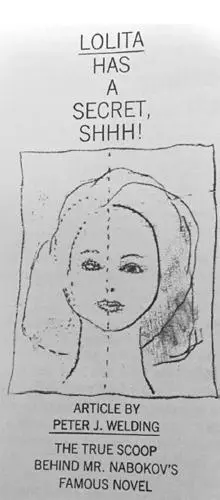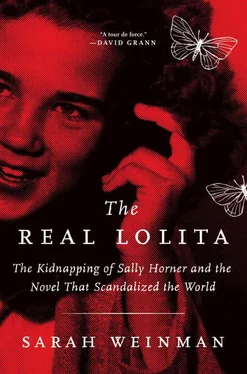Nabokov proved correct. The indefinite leave of 1958 became permanent retirement from Cornell at the end of 1959, when he was sixty. Lolita ’s success enabled his permanent break with the United States, though he would continue to insist, years after moving to the Montreux Palace hotel in Switzerland, that he might return. But Switzerland’s advantageous tax laws were too much of a boon—as was a greater sense of control and privacy, as “Hurricane Lolita ” grew stronger and louder. Now that Nabokov could afford to write full-time, thanks to his most American book, he could embark upon his next phase: as a literary celebrity in voluntary exile, as opposed to the peripatetic refugee. He would see the country that gave him shelter, sanctuary, and the source material for his most famous novel again only a handful of times.
Lolita moved far beyond the bestseller list to become a cultural and global phenomenon. The template was in place for generations of readers to be taken in by Humbert Humbert, forgetting that Dolores Haze was his victim, not his seducer.
At the time, no one noticed that Lolita was published in the United States on the sixth anniversary, to the day, of Sally’s death. And no one made the connection between fictional nymphet and real girl for several more years.
Twenty-Seven
Connecting Sally Horner to Lolita
Peter Welding was a young freelance reporter in 1963, still a few years shy of thirty. A Philadelphia native, he had already built up a solid series of bylines, mostly for music magazines like Downbeat . He was also a fledgling music producer, founding Testament Records that same year to issue old and new jazz, gospel, and blues recordings. Welding had moved to Chicago to further his producing career, but not before setting out to tell a story that unfolded across the river from his hometown.
Welding was born in 1935, two years earlier than Sally Horner; no doubt her kidnapping and rescue made a large impression on him as a teenager. Welding remembered reading of Sally’s plight in his local newspapers, the Philadelphia Inquirer and the Evening Bulletin, and decided to examine the parallels between Sally’s story and Lolita . He zeroed in on the same parenthetical phrase that, decades later, first caught the attention of Nabokov scholar Alexander Dolinin and, then, me. He compared specific events that occurred in Lolita to what happened to Sally. The results were published in an unusual venue: the men’s magazine Nugget, racier than Esquire or GQ but more prudent than Playboy .

Image accompanying Peter Welding’s November 1963 article for Nugget .
Nugget had a knack for publishing stories with literary connections. It helped that its editor at the time was Seymour Krim, who was affiliated with the Beat Generation, hanging around with Jack Kerouac, Allen Ginsberg, and Neal Cassady, though unlike them, he never wrote poetry or fiction. Krim also embraced the New Journalism ethos while working at the New York Herald Tribune with future stars Tom Wolfe, Jimmy Breslin, and Dick Schaap. Nugget, under Krim’s editorial guidance, featured stories and articles by Norman Mailer, James Baldwin, Otto Preminger, William Saroyan, Chester Himes, and Paddy Chayefsky—and that was just in 1963.
Despite shooting for high literary quality, Nugget wanted to reach a mass audience—though Krim and his staffers sabotaged their own efforts by failing to stick to a regular publishing schedule. Just five issues of Nugget appeared in 1963; Nugget ’s frequency during Krim’s editorial tenure might be best described as “bimonthly-ish.” Welding’s story, “ Lolita Has a Secret—Shhh!” ran in the November issue.
The piece opened with a summary of both Lolita and Sally’s abduction, which Welding had gleaned entirely from news reports in his hometown papers, the Inquirer and Evening Bulletin . He recounted the five-and-dime meet-up, La Salle’s threat of juvenile incarceration if Sally didn’t go along with his plan, the basic outlines of the twenty-one-month-long cross-country trip, Ruth Janisch’s role as rescuer, and Sally’s eventual recovery. [5] Oddly, Welding referred to the girl as “Florence ‘Sally’ Ann Horner.” It is a mystery why he gave her a middle name that was never reported and did not exist. The error continued to propagate, also cited by Alfred Appel, Jr., in The Annotated Lolita .
After Welding finished with his summary, he declared that the Horner case and Lolita “parallel each other much too closely to be coincidental.” Welding took particular note of Sally’s fear of being sent to reform school, which he compared to Humbert’s declaration, roughly halfway into the novel, that “the reformatory threat is the one I recall with the deepest moan of shame.” And further:
“…What happens if you complain to the police of my having kidnapped and raped you?… So I go to jail. Okay. I go to jail. But what happens to you, my orphan?… While I stand gripping the bars, you happy neglected child, will be given a choice of various dwelling places, all more or less the same, the correctional school, the reformatory, the juvenile detention home….”
Welding also drew a comparison between Humbert marrying Charlotte Haze to gain access to Dolores and La Salle claiming to be married to Sally’s mother. Welding further speculated that the actions of Humbert’s housekeeper at Beardsley, Mrs. Holigan, might be based on the actions of Ruth Janisch (“on the rare occasions where Holigan’s presence happened to coincide with Lo’s, simple Lo might succumb to buxom sympathy in the course of a cozy kitchen chat”).
Finally, Welding arrived at his own smoking gun: that neon-light parenthetical late in Lolita: “in this single reference [Nabokov] has all the essentials—the full names, the ages of the pair, La Salle’s occupation, the date of the abduction— neatly packaged in one sentence,” which suggests thorough familiarity rather than casual knowledge.
Eventually Welding seemed to tire of the compare/contrast—“More parallels could easily be shown, but to what further purpose?”—but he felt confident enough to conclude: “The plot line of Lolita derives in large measure from the case and is solidly based on actual fact…. The conclusion is almost inescapable: Nabokov has inserted the reference to the LaSalle-Horner story either as a conscious (or unconscious) acknowledgment of a primary source material, or as a shrewd maneuver to provide himself legal protection.”
I’m not certain what Welding meant here. He didn’t elaborate further in the piece, so I can’t know for sure, but perhaps he believed, based on this statement, that lawyers, already made nervous by Lolita ’s worldwide controversy, legal challenges, and publication bans, insisted Nabokov insert the reference to avoid an additional legal issue, such as a plagiarism charge.
Welding made several mistakes in his piece. First, he got Humbert’s parenthetical comment wrong, suggesting that it was from the vantage point of Mrs. Chatfield, the mother of one of Lolita’s classmates whom Humbert meets in a hotel lobby upon his return, after more than five years away, to Ramsdale. Still, Welding understood the importance of the Sally Horner aside decades before anyone else.
More baffling to me was his omission of Sally Horner’s fate from the article. Was Welding unaware that Sally died in a car accident a decade earlier? Could the “shrewd maneuver” line have referred to possible grounds for Sally to sue, had she been alive? In omitting Sally’s death, he missed an opportunity to compare her fate to Charlotte Haze’s death by car accident. What was beyond Welding’s grasp, though, was the direct proof Nabokov knew all about Sally Horner, since the transcribed and reworked wire report that is part of his archives at the Library of Congress was not available to the public in 1963.
Читать дальше













